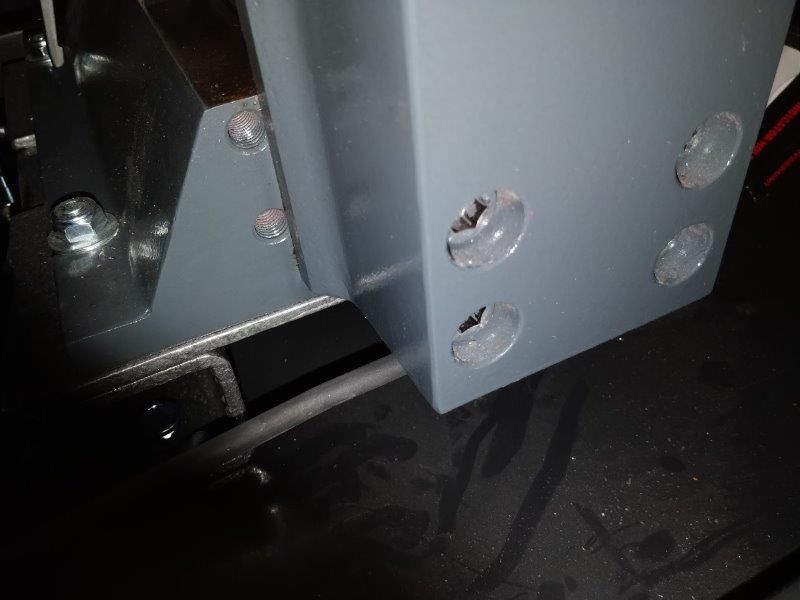Sorry if this a bit pushy, but here's what I'd do and indeed what I did on my own BF-20….. it's not a quick fix, but it's a good thing to know.
Tram the tilting head to the table with a dti, to ensure she's not rotated left to right.
Tram it front to back, to see if she's tilting forwards or backwards.
Great, lets, say it's perfectly square – you now have two useless pieces of information, relative only to an arbitrary reference because you've assumed your dovetail column is perpendicular in two planes AND you've assumed the rotating circular surface of the vertical saddle is also square in two planes……. (or you used an engineers square, and assumed or accept the inaccuracy of your square/surfaces/measurements) – often with machines of far eastern origin, if they're not square at every step of the way and they don't mind. They just grind a bit off (usually off one single bit) here and there to get the final figures – as soon as your start raising and lowering the head, or rotating the mill head, you're assuming things move square and true, and they probably dont.
Best not to assume anything these days.
so let's go back a step and try to derive accuracy, assuming only reasonable things. Remove the table from the equation, forget it exists for now, so dont worry about that bolted connection . You now have a column, a saddle with a 360 degree surface, and a spindle axis. Its not unreasonable to assume your column dovetail was machined in a single pass and is pretty much square and true, if you've got a micrometer you could check it's parallel, but I don't think you'll gain much.
Imagine now, that this column is laid down in front of you, with the spindle box on the left, as a lathe would be setout. (forget the table exists, remove it from your imagination). Now, you have a lathe without a saddle for a tool post, but who's spindle box can rotate on its own saddle.
To check this rotating face is parallel in two planes, isn't easy, since right and left, you have no column, no reference, and probably isn't necessary unless you're attempting to split the atom in your shed (it's been done…..) but you can check it in one plane ((THIS IS OPTIONAL, NICE TO KNOW KINDA THING)), along the axis of the column. Simply move the saddle to centre, and mount a DTI in the spindle. Rotate the spindle box 360 degrees, taking 4 measurements as you pass the lower face of each dovetail – making sure you don't move the guage.
assuming you're 360 saddle is true….. move on.
now check out rollies dads method of spindle alignment, you can adjust very easily to align it towards or away from you (imagining it's laid down like a lathe) – however if you're spindle is pointing up or down along the axis of the "bed" (again, imagining its a lathe) – this is a more serious issue, it means the alignment of the quill bore, is knackered – the only option is to remachine the circular face on the back to correct the up/down movement – if it's out in the other plane…. it doesn't actually matter that much (imagine it being mounted on a hinge like a door, opening and closing, it doesn't matter where it swings, so long at it's not dropping or lifting along the axis of the column……)
still with me?
no, me neither………
so if you successfully determined that your 360 rotating face, is square, and you've determined that your quill isn't pointing towards or away from column, then you can now go back to square one (almost)
"Tram the tilting head to the table with a dti, to ensure she's not rotated left to right.
Tram it front to back, to see if she's tilting forwards or backwards."
You can't tram left and right to the table, because you don't know if your spindle is aligned to the column unless you've just done the rollies dads method to alight the spindle left/right. So now when assuming you've done that, when you "Tram the tilting head to the table with a dti, to ensure she's not rotated left to right." – the difference is – if you're out, it's the column that's out, and not any errors in the alignment of the rotating spindle box or the trueness of the 360deg spinning face.
The only accuracy you're accepting, is the spindle runnout – which can easily be quantified – you actually already have all the measurements you needed to know from the rollies dads method, so you can acutally offset then values and incorporate this – but seriously, this is getting silly, but its there if you want perfection,
I'd consider that a mechanical QED (almost)….. now, if you still need that shim, you know you're not offsetting an error in your spindle to column alignment………
that was taxing……. I'd started writing an article for the magazine but I'm a long way from home right now, so don't have it…. this is all off the top of my head, but I think this is right, I spent quite a while working this out – the measurement and checks are actually simple in the end if you think about it……..
Edited By Russ B on 10/11/2017 08:18:56
Russ B.





